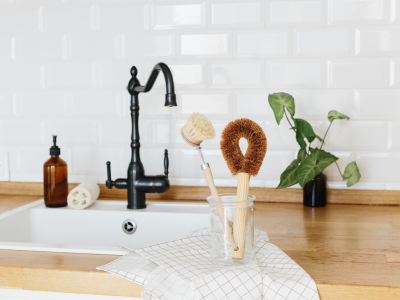
Conquer Stains on Kitchen Sinks and Appliances…Naturally
Kitchens should be used and enjoyed. But over time, unsightly stains can appear on appliances and in your sink. Try using these cleaning tips to naturally remove food, rust, and other stains from three common kitchen culprits.
1. Stainless Steel Sinks and Appliances
Stainless steel isn’t always stainless. Food stains, rust, and even hard water can stain your stainless sinks, counters, or appliances.
The easiest way to preserve stainless steel's appearance is to wipe it dry after every use. But if it’s too late for that, try dampening the surface and sprinkling dry baking soda on it. Using a soft cloth, sponge, or toothbrush, gently rub in the same direction as the grain. Baking soda can help lift stains and polish stainless steel without being overly abrasive.
This is the best method to remove rust stains, too, although you may need to let the damp baking soda sit for a while and apply a little “elbow grease” to the cleaning process.
For tougher stains, make a paste of cream of tartar, water, and lemon juice or hydrogen peroxide. Spread the paste on the stains and let it sit for a few minutes. Then, scrub with a soft cloth or sponge. Rinse thoroughly since the residue of gritty cleaners can damage stainless steel’s surface. Dry thoroughly after rinsing to keep the surface streak-free.
Never use steel wool or any solutions in the chloride family (fluorine, chlorine, bromine, iodine, etc.) on stainless steel since they will damage the surface.
If you want to add a little additional pizazz to your newly stain-free stainless steel, shine with a few drops of olive or coconut oil.
2. Enameled Cast Iron and Porcelain Sinks
Beautiful, classic, and brimming with vintage appeal for purists, these sinks are also prone to food stains from tomatoes, blueberries, tea, and coffee, black marks from metal pans and utensils, and rust stains from carbon steel knives and cast iron skillets.
Porcelain sinks are more tolerant of abuse than enameled cast iron ones, which are prone to chipping and scratching. But it’s best to treat both types gently.
Although a bleach-infused abrasive cleanser will get the job done quickly, harsh chemicals and abrasives can etch your sink’s surface over time, making it dull and giving future stains a stronger hold.
Dishwashing liquid is your first stop for cleaning an enameled or porcelain sink. If you need a bit more cleaning power, dampen the surface with water, sprinkle with baking soda, and scrub with a soft cloth or sponge.
For stubborn stains, cut a lemon in half, salt the cut side, and rub it over stains. This natural bleaching agent is not only lemon-fresh; it won’t damage your sink’s surface.
You can also try lifting difficult stains with a towel soaked in hydrogen peroxide.
If rust stains don’t respond to the above treatments, cover them with table salt and squeeze the juice of half a lemon until the salt is wet. Let it soak for several hours. Scrub the stain with the remaining lemon half or a soft cloth, then rinse.
While black marks aren’t technically stains, they can be difficult to remove. Start by dampening the surface and sprinkling baking soda over the marks. Add a layer of paper towels and spray hydrogen peroxide on the towels until they are soaked. After several hours, remove the paper towels, wash away the baking soda, and thoroughly rinse the sink.
3. Rubber Seals
The rubber gaskets around the edges of dishwasher, freezer, and refrigerator doors may also suffer from mold and food stains.
To help resolve these stains:
- Mix a tablespoon of baking soda with a quart of warm water.
- Wipe the seals with a soft cloth dipped in the solution to sanitize, deodorize, and get your gaskets sparkling clean.
- Rub between the ridges using a cotton swab or a soft toothbrush.
If your gaskets are still dingy, try using a diluted mixture of hydrogen peroxide and dishwashing detergent, but be sure to rinse well afterward.
Aside from eliminating grime, mold, mildew, and odd smells, cleaning your appliance seals will help your kitchen equipment work more efficiently and last longer.
One note of caution: cleaners with ammonia, bleach, or a petroleum base might damage appliance seals. Although vinegar is hailed as a fix-it-all cleaner, it’s a byproduct of fermented ethanol, an acid, which can cause some seals to deteriorate.
